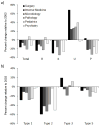Recent trends in National Institutes of Health funding for surgery: 2003 to 2013
- PMID: 25929766
- PMCID: PMC4446185
- DOI: 10.1016/j.amjsurg.2015.01.015
Recent trends in National Institutes of Health funding for surgery: 2003 to 2013
Abstract
Background: The purpose of this study is to compare the compositions of federally funded surgical research between 2003 and 2013, and to assess differences in funding trends between surgery and other medical specialties.
Data sources: The National Institutes of Health (NIH) Research Portfolio Online Reporting Tool database was queried for grants within core surgical disciplines during 2003 and 2013. Funding was categorized by award type, methodology, and discipline. Application success rates for surgery and 5 nonsurgical departments were trended over time.
Conclusions: Inflation-adjusted NIH funding for surgical research decreased 19% from $270 M in 2003 to $219 M in 2013, with a shift from R-awards to U-awards. Proportional funding to outcomes research almost tripled, while translational research diminished. Nonsurgical departments have increased NIH application volume over the last 10 years; however, surgery's application volume has been stagnant. To preserve surgery's role in innovative research, new efforts are needed to incentivize an increase in application volume.
Keywords: Academic surgery; Mentorship; National Institutes of Health; Outcomes research; Research funding; Surgical research.
Copyright © 2015 Elsevier Inc. All rights reserved.
Figures



References
-
- Addona T, Polcino M, Silver L, Taub PJ. Leadership trends in plastic surgery. Plast Reconstr Surg. 2009;123:750–753. - PubMed
-
- Colaco M, Svider PF, Mauro KM, Eloy JA, Jackson-Rosario I. Is there a relationship between national institutes of health funding and research impact on academic urology? J Urol. 2013;190:999–1003. - PubMed
-
- Sanfey H. Promotion to professor: A career development resource. Am J Surg. 2010;200:554–557. - PubMed
-
- Sanfey H, Gantt NL. Career development resource: Academic career in surgical education. Am J Surg. 2012;204:126–129. - PubMed
-
- Kotchen TA, Lindquist T, Malik K, Ehrenfeld E. NIH peer review of grant applications for clinical research. JAMA. 2004;291:836–843. - PubMed
Publication types
MeSH terms
Grants and funding
LinkOut - more resources
Full Text Sources
Other Literature Sources

